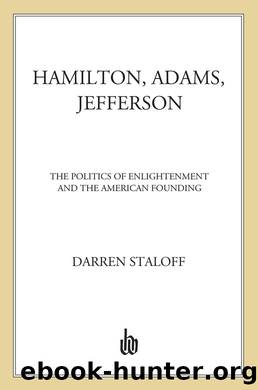Hamilton, Adams, Jefferson by Darren Staloff

Author:Darren Staloff
Language: eng
Format: epub
Publisher: Farrar, Straus and Giroux
Published: 2011-09-26T00:00:00+00:00
The Crisis Defused: John Adams and the Treaty of Mortefontaine
In the months following the disclosure of the XYZ Affair, hostilities with France intensified. As the public exploded in paroxysms of patriotic rage, many High Federalists pressured Adams for a formal declaration of war, an act that would devastate their Francophile Republican opposition and almost assure the victory of the president and his party in the next election. At first appearance, Adams seemed eager to comply. In June he had informed Congress that he would ânever send another minister to Franceâ unless given prior âassurances that he will be received, respected, and honored as the representative of a great, free, powerful, and independent nation.â Six months later Adams remained every bit as bellicose. The Directoryâs refusal to rescind its orders of the previous January targeting American shipping convinced him that only âan efficient preparation for warâ could possibly âensure peace.â With the solid support of his party and an opposition in retreat, Adams seemed poised to lead his country into its first large-scale war since its founding. The Federalist ship dominated the political seas, and a truculent President Adams was securely at the helm.163
Then without warning, John Adams transformed the political landscape. On February 18, 1799, he nominated William Vans Murray as âenvoy Extraordinaryâ to the French Directory. Adams took this dramatic measure entirely on his own initiative, without even consulting his own cabinet. The political impact was enormous. Republicans were rejuvenated and Federalists divided. The moderate wing of his party embraced Adamsâs initiative. Attorney General Charles Lee and Navy Secretary Benjamin Stoddert congratulated the president on his statesmanship, and John Marshall praised his âwisdom and courage.â High Federalists, however, were apoplectic. Less than one month earlier Hamiltonânow their undisputed leaderâhad urged a formal declaration of war. They now saw Adamsâs abrupt nomination of Murray as both pusillanimous and politically suicidal. A delegation of five High Federalist senators, led by Theodore Sedgwick, called on Adams, threatening to block the nomination. Adams was adamant. If Murrayâs nomination was blocked, he threatened to resign the presidency to Thomas Jefferson. He did, nonetheless, agree to add two additional envoys to join Murray. Two days later, on February 25, he nominated Oliver Ellsworth and Patrick Henryâthe latter replaced, when he declined, by Federalist governor William Davie of North Carolinaâto join Murray as members of a fresh peace commission, a nomination that was shortly ratified.164
At first glance, Adamsâs abrupt about-face seems impulsive, if not foolhardy. His heroic defiance of the previous year sounded hollow as he proposed to sue for peace once again after promising to never do so without prior assurances from Talleyrand, assurances that had not been officially received as yet. Feeling betrayed, High Federalists lashed out, rejecting Adamsâs leadership of the party and actively opposing his measures. Yet on closer inspection, Adamsâs change of mind seems far less precipitous. He had always favored a diplomatic solution to the Quasi-War. In fact, he had broached the idea of a fresh embassy to Secretary of State Pickering in late October 1798 and the rest of the cabinet the following month.
Download
This site does not store any files on its server. We only index and link to content provided by other sites. Please contact the content providers to delete copyright contents if any and email us, we'll remove relevant links or contents immediately.
| Americas | African Americans |
| Civil War | Colonial Period |
| Immigrants | Revolution & Founding |
| State & Local |
In Cold Blood by Truman Capote(3344)
The Innovators: How a Group of Hackers, Geniuses, and Geeks Created the Digital Revolution by Walter Isaacson(2991)
Steve Jobs by Walter Isaacson(2857)
All the President's Men by Carl Bernstein & Bob Woodward(2346)
Lonely Planet New York City by Lonely Planet(2194)
And the Band Played On by Randy Shilts(2165)
The Room Where It Happened by John Bolton;(2133)
The Poisoner's Handbook by Deborah Blum(2108)
The Murder of Marilyn Monroe by Jay Margolis(2078)
The Innovators by Walter Isaacson(2074)
Lincoln by David Herbert Donald(1962)
A Colony in a Nation by Chris Hayes(1900)
Being George Washington by Beck Glenn(1775)
Under the Banner of Heaven: A Story of Violent Faith by Jon Krakauer(1764)
Amelia Earhart by Doris L. Rich(1668)
The Unsettlers by Mark Sundeen(1658)
Dirt by Bill Buford(1649)
Birdmen by Lawrence Goldstone(1638)
Zeitoun by Dave Eggers(1615)
